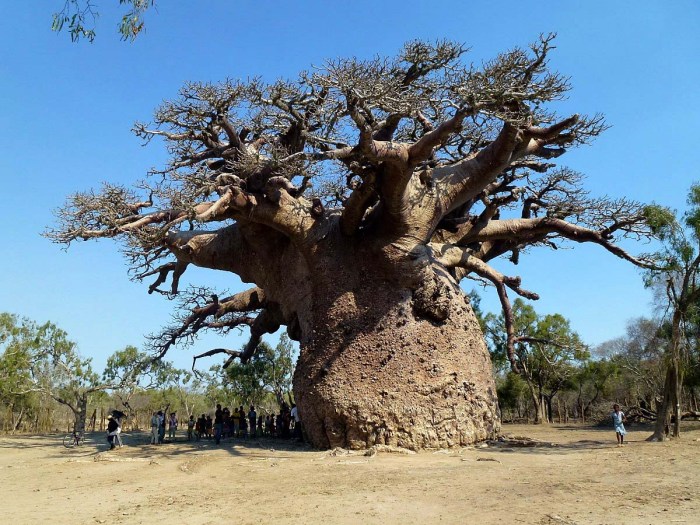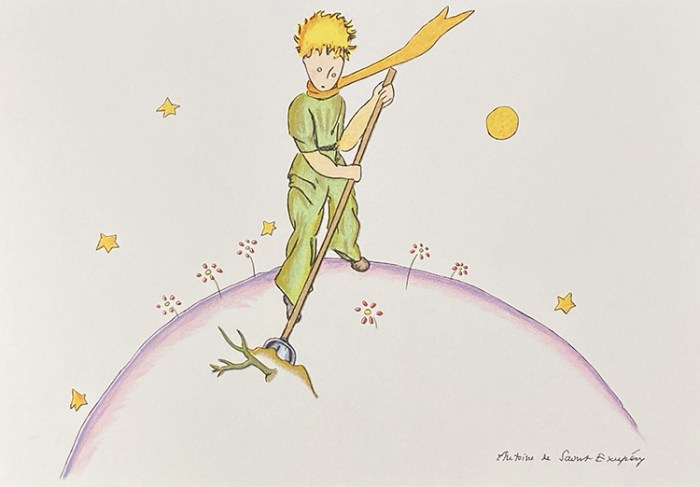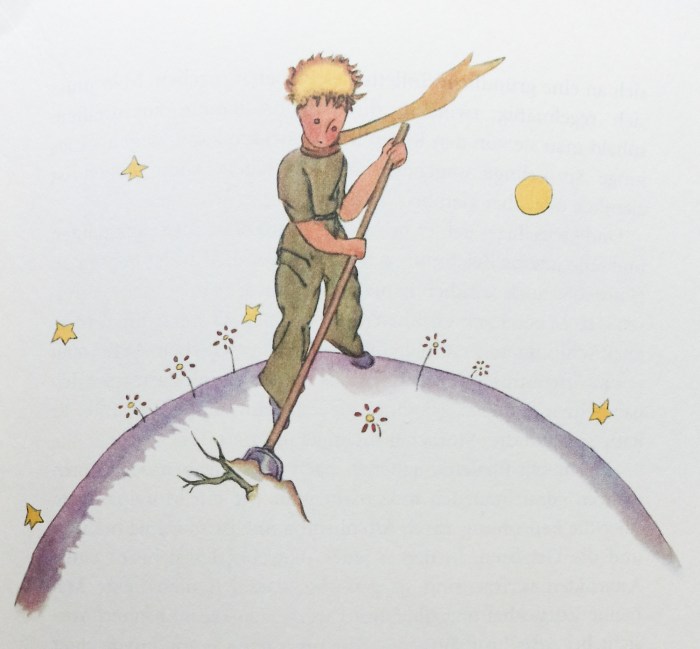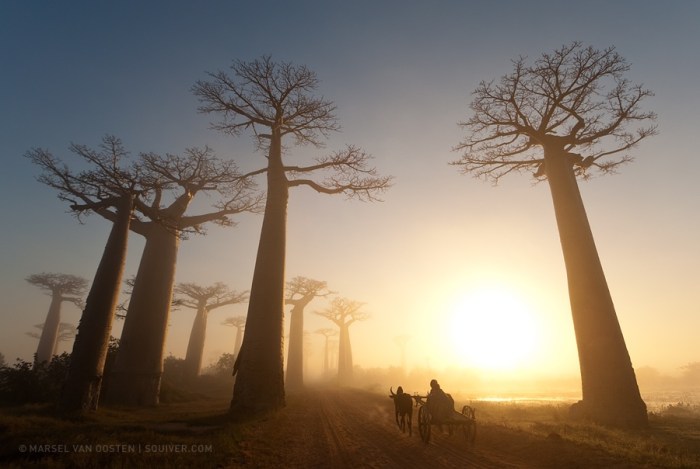Baobab tree the little prince – In Antoine de Saint-Exupéry’s beloved tale, “The Little Prince,” the enigmatic baobab tree emerges as a profound symbol of strength, resilience, and the enduring power of home and belonging.
This extraordinary tree, with its deep roots and sprawling branches, serves as a poignant metaphor for the protagonist’s personal journey, representing both the challenges and triumphs he encounters along the way.
The Baobab Tree

In Antoine de Saint-Exupéry’s classic tale, “The Little Prince,” the baobab tree holds profound significance. It represents both the strength and resilience of nature and the dangers of unchecked growth.
Unique Characteristics
The baobab tree is a native of Madagascar, known for its immense size and distinctive appearance. Its trunk can grow up to 100 feet in circumference, and its branches can spread up to 150 feet wide. The tree’s roots are shallow, but they extend deep into the ground, providing it with a solid foundation.
These characteristics reflect the protagonist’s journey, as he faces challenges with determination and develops a deep understanding of the world.
Uncontrolled Growth
While the baobab tree is a symbol of strength, it also poses a threat. If left unchecked, its seeds can quickly germinate and spread, choking out other vegetation and disrupting the ecosystem. Similarly, the protagonist’s unchecked desires and emotions can lead to negative consequences, highlighting the importance of self-control and responsibility.
Responsibility and Care
The protagonist learns that tending to the baobab trees is crucial for maintaining balance in his world. By uprooting the young sprouts, he prevents them from overwhelming the planet. This emphasizes the responsibility we have to care for our environment and to prevent unchecked growth from causing harm.
The Baobab Tree as a Metaphor for Growth and Overcoming Obstacles: Baobab Tree The Little Prince

The baobab tree in The Little Prince serves as a potent metaphor for personal growth and overcoming challenges. It symbolizes the protagonist’s struggles and triumphs as he navigates the complexities of life and relationships.
The baobab tree, as depicted in “The Little Prince,” is a symbol of stubbornness and resilience. To delve deeper into this concept, I recommend taking the ASL Unit 1 Comprehension Test , which explores the nuances of communication and understanding.
Returning to the baobab tree, its ability to withstand the harsh desert environment serves as a poignant reminder of the strength and perseverance we all possess.
The Baobab Tree as a Representation of Personal Growth
The baobab tree’s immense size and deep roots represent the protagonist’s potential for growth and resilience. Like the tree, the protagonist must confront and overcome obstacles to reach his full potential. The act of uprooting the baobab trees signifies the protagonist’s determination to overcome challenges and embrace new experiences.
The Baobab Tree as a Metaphor for Overcoming Obstacles
The baobab trees’ destructive nature, if left unchecked, symbolizes the protagonist’s inner struggles and the challenges he faces. The protagonist’s battle against the baobab trees represents his fight against adversity and his refusal to be consumed by negative thoughts or emotions.
By confronting and overcoming the baobab trees, the protagonist demonstrates his resilience and determination to forge ahead despite the obstacles he encounters.
The Importance of Nurturing and Caring for the Baobab Tree
In the tale of The Little Prince, the baobab tree serves as a potent symbol of the need to nurture and care for the natural world. The protagonist’s interactions with the tree highlight the profound impact humans can have on the environment, both positive and negative.
When the Little Prince first encounters the baobab trees on his home planet, he is shocked by their destructive potential. If left unchecked, these invasive trees can quickly overwhelm and suffocate the planet, threatening its delicate ecosystem. The protagonist’s diligent efforts to uproot the young baobabs are a testament to the importance of protecting nature from such threats.
Nurturing Growth and Overcoming Obstacles
Conversely, the protagonist’s care for the baobab tree on the planet B-612 symbolizes the transformative power of nurturing and cultivating nature. By watering and tending to the tree, the Little Prince not only ensures its survival but also fosters its growth and beauty.
This act of care becomes a metaphor for the protagonist’s own journey of personal growth and overcoming obstacles.
The baobab tree, with its deep roots and resilience, represents the strength and determination required to face life’s challenges. By nurturing and caring for the tree, the protagonist learns the value of perseverance, patience, and the profound satisfaction that comes from witnessing the fruits of one’s labor.
The Contrast Between the Baobab Tree and the Rose

The baobab tree and the rose in The Little Prince represent contrasting aspects of the protagonist’s journey and the lessons he learns. The baobab tree symbolizes destructive habits and obstacles that must be overcome, while the rose represents beauty, love, and the importance of nurturing relationships.
The Baobab Tree: A Symbol of Destruction
The baobab tree is a large, invasive plant that can quickly overtake a planet. In the story, the baobab tree represents the destructive habits and obstacles that the protagonist must face on his journey. If left unchecked, these habits can destroy everything in their path, just as the baobab tree can destroy a planet.
The Rose: A Symbol of Beauty and Love, Baobab tree the little prince
In contrast to the baobab tree, the rose is a beautiful and delicate flower that requires careful care and attention. In the story, the rose represents the beauty, love, and relationships that the protagonist finds on his journey. Just as the rose needs to be nurtured and cared for to thrive, so too do relationships require attention and effort to flourish.
The Baobab Tree as a Symbol of Home and Belonging

In the story, the baobab tree serves as a significant symbol of home and belonging for the protagonist, the Little Prince. The tree represents stability and comfort in a world that is often unpredictable and unfamiliar.
The Little Prince finds solace in the baobab tree, as it provides him with a sense of familiarity and security. The tree’s large, sturdy trunk and expansive branches create a protective shelter, shielding him from the harsh elements and the vastness of space.
The tree’s roots anchor it deeply into the ground, symbolizing the Little Prince’s connection to the planet he has come to call home.
The Tree’s Nurturing Presence
The baobab tree also represents the nurturing and protective qualities of home. It provides the Little Prince with food, shelter, and a place to rest. The tree’s leaves and fruits offer sustenance, while its branches provide shade and shelter from the sun and rain.
The tree’s presence is a constant reminder of the love and care that the Little Prince has found on his adopted planet.
Top FAQs
What is the significance of the baobab tree in “The Little Prince”?
The baobab tree represents the challenges and obstacles that the protagonist must overcome on his journey, symbolizing both the difficulties and the resilience he develops along the way.
How does the baobab tree change throughout the story?
As the protagonist cares for and nurtures the baobab tree, it grows and flourishes, reflecting his own personal growth and transformation.
What does the baobab tree represent in contrast to the rose?
The baobab tree represents the wild and untamed aspects of nature, while the rose symbolizes beauty, love, and the importance of nurturing relationships.